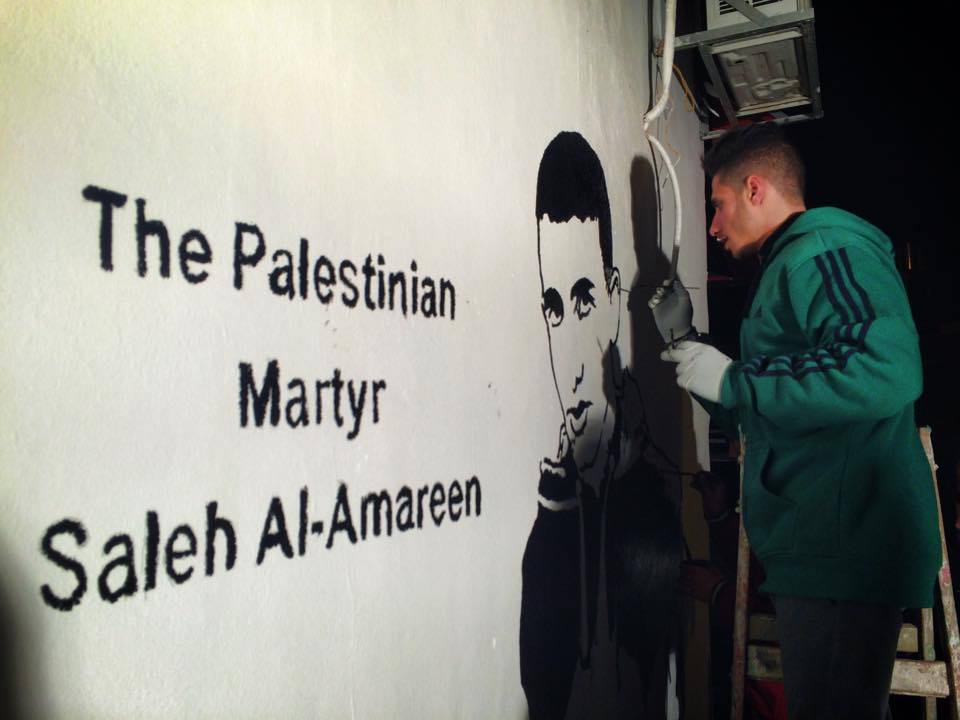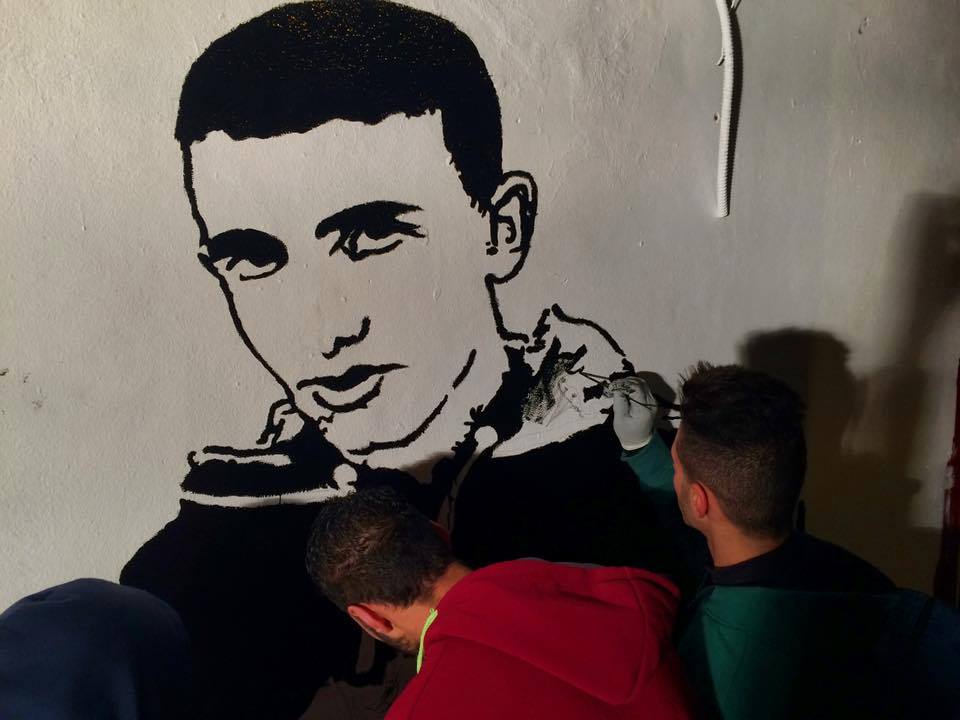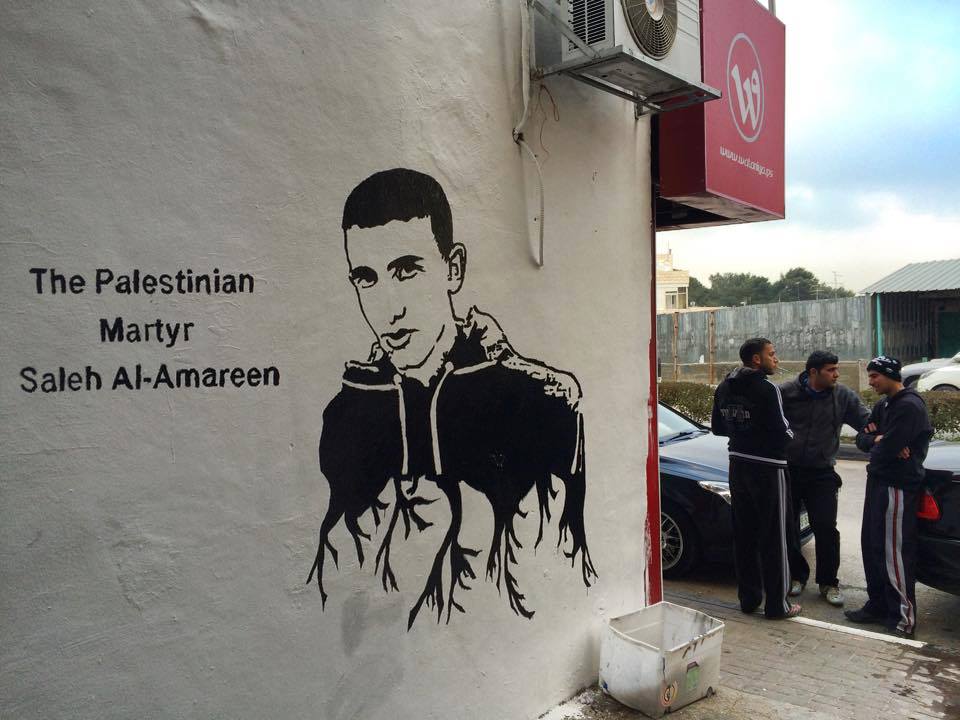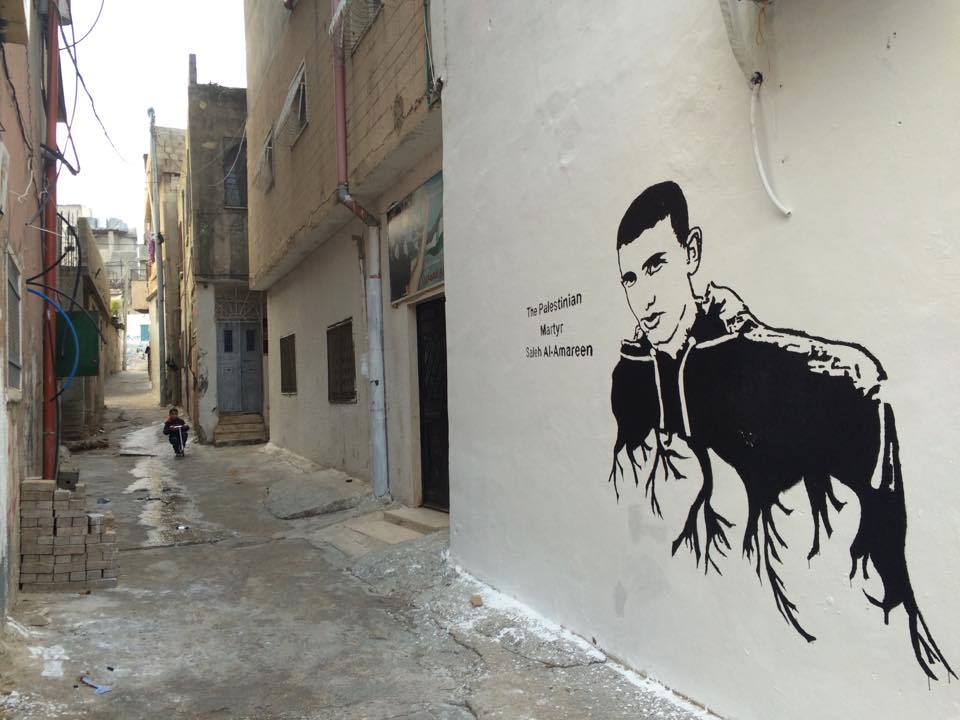Originally published on Ma’an News Agency on January 15, 2015.
BETHLEHEM (Ma’an) — As the second anniversary of the death of a young Palestinian boy from Bethlehem approaches, his friends came out to paint a mural on the wall of his childhood home to keep his memory alive.
15-year-old Saleh al-Amarin was shot in the head with a live bullet by Israeli soldiers in Aida refugee camp north of Bethlehem on Jan. 18, 2013, and he passed away five days later at a Jerusalem hospital.
For his friends and family, the pain of the loss has hardly subsided, and his visage has been spray-painted across much of the neighborhood. On Wednesday night, a mural went up on his house in Azza refugee camp to remind both locals as well as passing tourists of the loss the community suffered on a cold January day two years before.
Two of the muralists, brothers from the nearby Duheisha refugee camp where Saleh was a student, told Ma’an that the mural was a way for them to commemorate their friend and the way he died. For them, it was also a form of resistance.
“He was a close friend of mine, like my brother,” Ali Obeid, 17, told Ma’an as he took a break from painting.
“By painting these murals, I can express my feelings about his death and I’m also able to struggle against the Israeli occupation.”
“I don’t throw rocks (at soldiers), but I express myself and my freedom through these murals. Everything we express, the Israelis try to suppress. But by painting his face and his eyes on the wall, I can spread awareness of his martyrdom.”
Ali’s brother Muhammad, 18, also helped paint the mural.
“He was one of us, a young guy from the camps, so we knew each other well,” he told Ma’an.”We are painting this mural on the door of his home. But it is also on a main road that many tourists pass by. They should know that here there was a 15-year-old martyr who was killed even though he wasn’t doing anything.
“The Israeli military say Saleh was shot while a group of youths threw rocks at the eight-meter high concrete Israeli separation wall as it passes through the nearby Aida refugee camp, though eyewitness testimony directly contradicts the account and suggests nothing was happening at the time.
For locals — all of whom are refugees whose families were forced from their original homes in villages in what is now Israel in 1948 — whether or not Saleh was throwing rocks when he was shot is less important than the facts of the incident: an unarmed youth was shot dead by an Israel soldier holding a rifle, protected by a concrete barrier.


‘The martyr of three camps’
Saleh’s father, Ahmad al-Amarin, stood near the the crowd of his son’s friends as they painted the mural, smiling occasionally at the light-hearted jokes and staring wistfully at the greater-than-life portrait of his only son taking shape on the refugee camp wall.
“They call him the martyr of the three camps,” he told Ma’an, “because Saleh was studying at an academy in Duheisha, he was born and lived here in Azza, and he was martyred in Aida.”
“His friends paint these murals because they refuse to forget the dear friend of theirs that died, their brother, their beloved,” he told Ma’an, pointing at the crowd of youths from all over Bethlehem gathered as the mural took shape.
“His martyrdom caused a great shock for all of the kids around here, and it is clear they have not forgotten him … For me, mural or no mural, I won’t forget him.”
Saleh’s father spent the five days following his son’s shooting in the hospital at his bedside along with the rest of the family. Even two years later, he told Ma’an, he cannot understand why Israeli soldiers chose to kill his son, whose greatest dream in life was to play soccer in a professional league.
“They shot an unarmed child. What kind of danger did he pose to them?,” he asked, as the kids gathered around murmured in agreement.
“If he was carrying a rifle or if there was an exchange of fire, I can understand perhaps. But this was a kid walking around with nothing on him, and a soldier opened fire. Why do you shoot a child? Why do you kill him just like that?”
Al-Amarin also highlighted the deep sadness he felt on the day the doctors told him there was nothing that could be done to save Saleh’s life. After he passed away, the family brought him home to be buried in the cemetery of Aida camp, only a few meters from where he was shot.
His small body was laid to rest in a small white tomb overlooked by the same Israeli military watchtowers that gazed upon his wounded body as it lay bleeding on the pavement of the nearby street.


‘It’s as if we’re not even human’
Before the killing of his son, Saleh’s father used to work at a job in Jerusalem to earn money for his family. Once his son was killed, however, Israeli authorities took away his work permit, in a policy often meted out to those whose family members’ lives are taken by Israeli soldiers.
For Saleh’s father, the “punishment” he received only highlights the double standard faced by Palestinians under Israeli occupation.
“Imagine if he was an Israeli child and the Palestinian police shot him, what would have happened? They would have destroyed his home and punished his family. And for us what happens? Nothing!”
“They forget. It’s as if we’re not even human. They shoot us and there are no consequences.”
Palestinians continue to be killed with few consequences for their murderers, protected as they are by the uniforms of the Israeli military. 49 Palestinians were killed across the West Bank in 2014, and nearly 2,300 were slaughtered in Gaza in the same period.
Two years after Saleh’s life was taken, justice for his friends and family seems further than ever.
